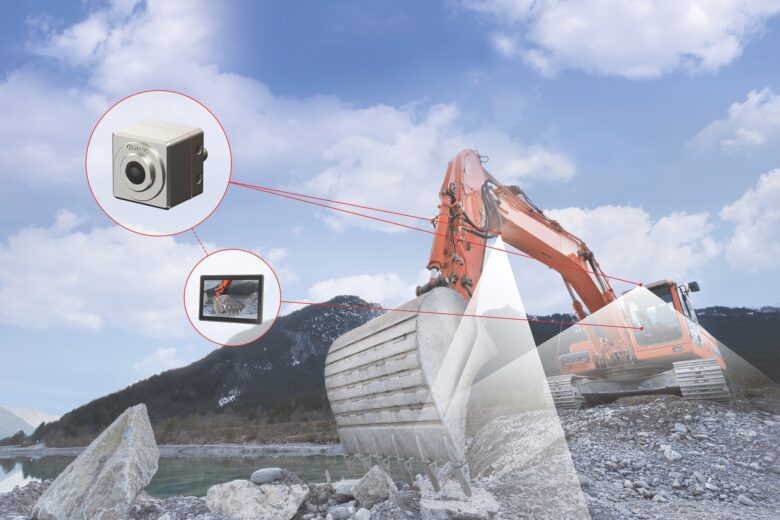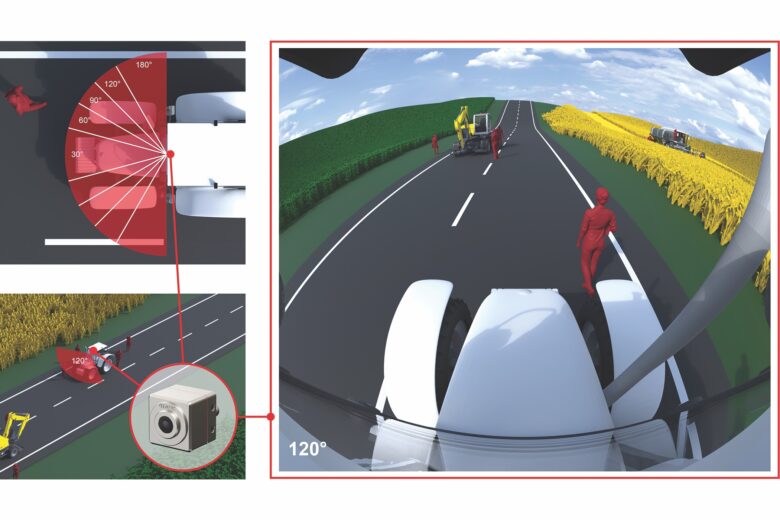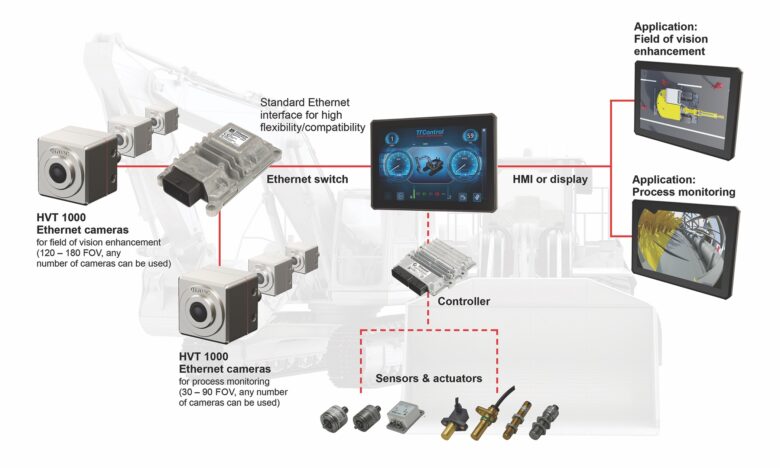Tailor-made solutions for field of vision enhancement are an important component of modern machines. Strict standards apply to the robustness and image quality as well as integration and handling. In light of this, HYDAC is expanding its existing product portfolio to include digital Ethernet cameras from the HVT 1000 product range for the off-highway market.

Due to the way that they are structured, vehicles and mobile machines have non-visible areas known as “blind spots.” To avoid this, there are solutions that extend the field of vision. The solutions traditionally involve rear-view or wing mirrors. But these aren’t able to cover all hard-to-see areas. This is why assistance systems for collision avoidance are increasingly being used in vehicles. These are primarily intended to prevent accidents with people but also damage to the vehicle. While in the past, mainly ultrasonic sensors were used in distance warning systems, cameras or a combination of cameras and ultrasonic technology are increasingly used today. These camera-based solutions provide the machine operator with much more information than ultrasonic sensors.
For a long time, analog cameras have been used to expand the field of vision on machines. With the digitalization of machines and the increasing need for merged data, digital sensors are gaining in importance. This is why digital camera systems are becoming more and more in demand. To suit the new system architectures of mobile machines and meet the associated new requirements for field of vision enhancement, HYDAC is expanding its extensive sensor range with the digital Ethernet camera HVT 1000.
Requirements for modern field of vision enhancement
In many cases, a camera can be a useful tool for “field of vision enhancement.” The top requirement for the components and the system is to provide the machine operator with a meaningful image of their environment.
For reverse cameras, a large field of vision of up to 180° is required. In contrast to cars, process monitoring can also be of interest in machines. A smaller field of vision is required here, typically between 30 and 90°, so that more detailed images can be given. To meet these requirements, the HVT 1000 offers a wide range of fields of vision. The camera lenses are also optimized for the increased demands on machines. This plays an important role when using high-pressure cleaners, for example. The field of vision is digitized internally by the camera. The resolution, frame rate and dynamic range are important here. A sensible limitation of the resolution and frame rate is made possible by the technical capabilities of the display device, for example.

Even complex control commands can be transmitted from the display to the camera
The amount of data generated by the camera is adapted to suit the display and the application. An excessive amount of data from the camera leads to a higher, avoidable processing load during processing in the HMI.
The same applies to dynamic range or color depth: monitors can only display a limited number of color and brightness levels. In practice, its high contrasts, such as backlight, which especially lead to problems. For this scenario, the HVT 1000 has a sensor with a HDR mode. It takes a series of images with different exposures and combines them into one image. This enables detailed images to be provided, even in poor light conditions. The camera can also transform the image and crop it depending on the application.
Special features of cameras in machines
When integrating cameras into the machine and in the case of spare parts, easy handling and mount-ability play a major role. To simplify installation or replacement, the HVT 1000 is equipped with two through holes that allow mounting with M6 screws.
The electrical interface and the connector also play a role, with Ethernet steadily gaining in importance as an interface. One reason for this is that new sensors send more data than the frequently used CAN-Bus can transmit. Ethernet offers a solution for this for sensors with a high bandwidth demand. When it comes to connectors, components for machines are often expected to be highly flexible as they have to adapt to the system. Depending on the application, solutions with connectors on the component or solutions with a cable outlet are advantageous. Last but not least, the camera electrics/electronics must meet the requirements for mobile machines, for example in order to be able to work with different supply voltages or to withstand electrical disturbances that occur. The HVT 1000 is equipped for this with special protective circuits.
Systems for field of vision enhancement
A camera itself is only one part of a system for field of vision enhancement. At a minimum, this consists of a camera, a connection cable and the display unit. If an Ethernet interface is used, Ethernet switches can extend the system with additional components to form a network. Theoretically, this means that any number of cameras (or Ethernet-capable sensors) can be connected to one or more end devices, such as displays or HMI’s. In practice, the number of devices in the network are limited by the available bandwidth.
But this flexibility also leads to new challenges. The camera and display/HMI must be coordinated with each other so that the display finds the image data stream in the network and interprets it correctly. To facilitate this, there are automotive standards on the basis of which it is possible to configure the Ethernet camera according to a standardized command set (ISO 17215). The digital interface doesn’t just transmit the video stream from the camera to the display. Even complex control commands can be sent from the display to the camera. These form the basis of new field of vision solutions which are created through the interaction between hardware and software.

New field of vision solutions thanks so digital image data, merging, and software
This allows the display/HMI to change the resolution or bandwidth of the camera with appropriate commands. This is useful if you want to switch between a full-screen image on the display and several smaller images, for example. The requirement-oriented data transfer rate reduces the stress placed on the processing unit in the display/HMI. The HVT 1000 supports this with its ability to create predefined field of vision configurations that are retrieved on command. It is also possible to change the image display, digitally adjust the field of view of the camera or control functions such as the internal camera heating.
With the HVT 1000, automatic functions, such as exposure control, can also be switched on and off or controlled externally by command. This becomes relevant when several images in the display need to be merged into a single top view or bird’s eye view. In this case, the cameras are adjusted by a central control unit in such a way that one homogeneous overall image is created. However, it’s not just image streams that can be merged in the display/HMI. If other sensors are connected to the HMI via a gateway, e.g. ultrasonic or radar sensors, it is possible to overlay this information on the displayed camera image. The user can also be made aware of a potential obstacle this way, for example. 360° environment monitoring around the machine can be made possible with the use of several HVT 1000 in combination with ultrasonic sensors and radar sensors.
Hydac
hydac.com
Filed Under: Components Oil Coolers, Mobile Hydraulic Tips, Sensors, Sensors & Gauges